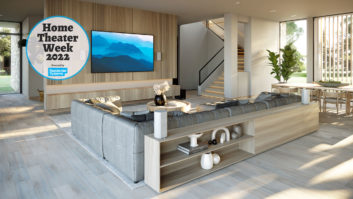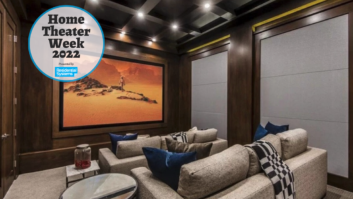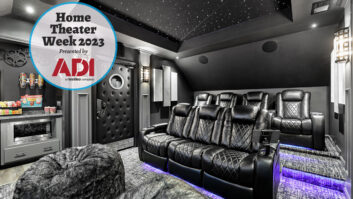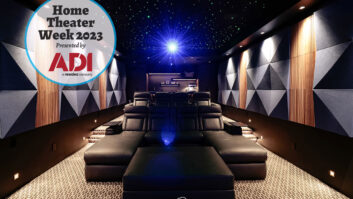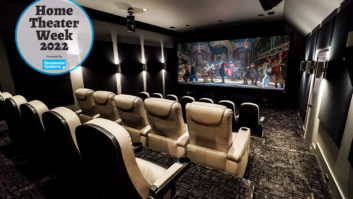HDMI has been with us for a while now, and all signs point toward it being here for the foreseeable future. And while we’ve mostly cleared the hurdles of handshake and dropout issues, distributing HDMI signals around the home still hasn’t hit mass market. Sure, technologies like RedMere active cables, wireless send/receive kits, and HDBaseT have helped with transmitting signals longer distances, but HDMI distribution still has its challenges. For one, HDBaseT requires a Cat-rated cable at each display location, which is somewhat unlikely in older homes. Also, HDMI matrix distribution systems are still quite costly, especially when you get above eight sources and eight displays.
At this past CEDIA I stumbled across a solution from Metra Home Theater that sounded almost too good to be true. The company claimed that its new Metra Multimedia Broadcast (M3B) products would send full-bandwidth, 1080p HDMI signals up to 700 meters over standard RG6 coax cabling that has been used in homes for decades. Oh, and the signal can live on the same RG6 cable line, along with digital cable, cable modem, satellite, and OTA signals. And, it is totally and massively scalable: just add as many transmitters (up to 100) and receivers as the job requires. This I had to see for myself!

The Metra Home Theater CS-HDM3BTX1Metra sent me three CS-HDM3BTX1 transmitters and three CS-HDM3BRX1 receivers, enough to create a three-source, three-display matrix. The wiring is so simple that I overthought it for days, drawing and emailing schematics to Metra’s main tech and following up with texts of, “Really? It’s that simple? Really?!”
Basically you just throw regular, everyday coax splitters into the existing wiring infrastructure, adding transmitters at source components and receivers at displays wherever you need them. And you can have transmitters and receivers sending back and forth on the same line through the same splitter. As long as the RG6 cabling comes back and all joins up together at some point in the home, the magic–and power–of the M3B will burn its way through all the mumbo-jumbo. It’s seriously crazy and is a total mind-flip of everything you thought you knew about cable wiring. If your typical cable TV installer came over and saw it, his head might literally explode.
My install was slightly complicated by the fact that I have DISH Hopper instead of cable, so I needed to use diplexers at each satellite receiver location. Because I didn’t have the correct diplexers to use with the Hopper node, the diplexing affected my DISH MoCA network. It didn’t, however, have any impact on the M3B’s operation.
The transmitter and receiver look virtually identical and are about the size of an extra-thick iPhone 5. Each is powered by 5-volt DC power, with a coax F-connector and HDMI. The receiver has a mini-jack connection for the included infrared receiver. In my install I sent DISH Hopper and Kaleidescape signals from my living room and DISH Joey from my bedroom to three different TVs. To get an idea of the wiring, my living room incoming RG6 went into a diplexer; the satellite line out to the Hopper, and the other RG6 line to a three-way splitter. Two feeds out of the splitter went to the transmitters for the Kaleidescape and Hopper, and the third feed went to the receiver that connected to my Marantz pre-pro via HDMI.
You assign each transmitter a channel, from 00- 99 (making 100), using two buttons on the front of each unit. Metra suggested keeping at least one channel in between, and ideally five, which still allows for 20 sources. Now, don’t get the word “channels” confused with TV channels because you aren’t using the TV tuner at all. This is the modulated channel created for each source by the CS-HDM3BTX1.
Each receiver comes with a credit-card-type remote that can be “learned” into any control system. (Metra also makes the hex codes available.) When I wanted to watch the Kaleidescape feed, I’d tune any receiver to channel 30, with the Hopper on 35 and the Joey on 40. The system is a bit sluggish changing channels, taking about six seconds to go from one to another. It didn’t, however, lose picture or sound prior to changing, and when it did change, the new channel appeared instantly. I also really liked that no settings were lost if there is a power interruption. Even after being unplugged for several days, the system remembered all channel assignments.
I didn’t notice any picture-quality issues, artifacts, or anything else untoward video-wise going through the M3B versus a straight HDMI connection. It had no issues passing full Blu-ray quality from the Kaleidescape and looked terrific on all three sets, even though it traveled a convoluted route, for a long distance, through RG6 cabling, a variety of splitters, diplexers, and the DISH node outside my house.
My only real nit with the system is that audio is limited to 2-channel PCM. This is actually not due to any technical limitations of the Metra, but rather was a design choice because of some display’s limitation in accepting 5.1 audio on their HDMI inputs. Unfortunately this means the M3B really limits the audio performance of a system, meaning you likely wouldn’t want to use it when connecting to a surround system.
The Metra M3B is a wonderful problem solver that worked exactly as promised and makes it possible to set up an incredibly affordable and scalable HDMI matrix system in virtually any home. If Metra decides to enable full audio bitstream pass-thru, it could be truly revolutionary.
866.839.9187
MetraHomeTheater.com
Kudos
Scalable HDMI matrix distribution in virtually any home; incredibly robust operation; affordably priced
Concerns
A bit slow to change “channels”; limited to PCM 2-channel audio
Product Specs
► Fully compatible with HDCP
► Transmits signals up to 1080p/60 up to 700 meters via standard RG6
► PCM 2-channel audio
► Supports up to 100 channels
► Support IR control channel switching with included remote
► Works in conjunction with cable, satellite, and OTA signals
